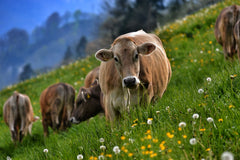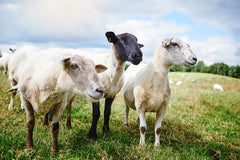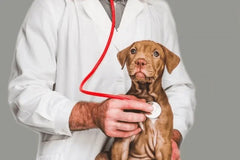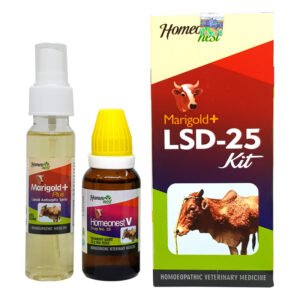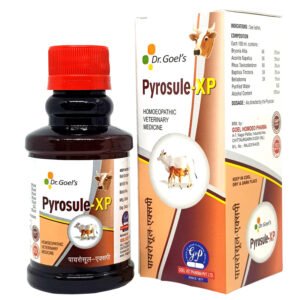
ABORTIGO: No Tension Of Abortion in Cow
India as a developing nation still relies on its ancient roots to date. Agriculture, and dairy farming continue to stay at the epicentre of this nation’s growth and progress sector. People here have a great connection with India’s rich history and culture, where cows & cattle are given eminent position in society as they support not only the farmers’ family but also many households through milk, milk products [nutrition] and contributes to farming as well in the form of farming aid. The dairy industry is one of the leading industries that contribute greatly to the Indian economy. As of 2020, despite the pandemic, the dairy sector has continued to boom and increase our nation’s GDP [Gross Domestic Product] with around 4.2% of the total GDP percentage being contributed by our Dairy Sector. Also, it is interesting to note that this sector particularly continues to grow annually at the rate of 4.9% which is a really good indicator of economic growth and boom. According to the latest research conducted on the total value of the dairy sector of India, the dairy market in India reached a value of 11,357 billion in the year 2020. That being said, there is a symbiotic environment, where the milch animals provide farmers with milk, and the farmer provides them with good facilities such as food, shelter etc. supporting each other’s livelihoods. One of the grave obstacles which may stand firmly in the way of dairy farmers and cattle is abortion. Abortion being both a physically and mentally difficult process for the cattle it does significantly affect the cattle-farmer as well who is dependent upon milk and its products for their livelihoods. Today, let us understand more about abortion, the cause-effect and the outcomes, treatment, and preventive measures for the same.
ABORTION: CAUSES & REASONS
Abortion refers to the termination of pregnancy after organogenesis is complete but before the expelled foetus can survive. It is the loss of an embryo during pregnancy that is not a favourable event and it does have a wide variety of reasons which culminates into this unfortunate event. Let us try to understand the reasons or causes of abortion –
Broadly, abortion -causes can be divided into two broad categories –

A] INFECTIOUS CAUSES:
Infection refers to different bacterial and viral pathogens which infect the bodytriggering the disease process. There is a wide range of bacterial and viral agents that propagate and affect the reproductive tract leading to reproductive-tract related diseases and conditions such as reproductive failure, localised infectionsand abortion in pregnant cattle.
1. Blue Tongue Virus
Caused by Orbivirus having 24 serotypes, this virus is transmitted via biting midges such as Cullicoides spp. Abortion, mummification of the foetus, the birth of a live foetus with severe CNS [brain] malformations, and stillbirth are common features of this.
2. BVD Virus [Bovine Viral Diarrhoea]
BVDV or bovine viral diarrhoea virus is one of the most common agents causing an abortion in cattle. It is transmitted via a number of ways –
- It can be transmitted via the placenta [from mother to foetus]
- It can be transmitted via fomites [infected objects/ transport objects etc.]
- It can be transmitted via direct contact with an infected animal
Of these, lets focus on the placental transmission of BVDV.
As this virus has the ability to be transmitted via the placenta to the growing foetus, it can cause foetal death and abortion, malformed foetus, still-birth or some cows may even deliver the foetus despite being infected. When infected during the organogenesis process [when organs are being developed in the foetus] it can cause serious developmental anomalies such as cerebellar hypoplasia, hydrocephalus, spinal cord hypoplasia, etc.).
3. Brucella
This bacterium – brucella abortus, is quite a notorious bacteria and abortion is the prime feature. This Is a zoonotic disease as well! The organisms enter via the mucous membranes and tend to invade the uterus, triggering inflammation of the placenta [termed placentitis] in pregnant animals which may be acute or chronic in nature. Abortion occurs at around 2 weeks to 5 months after the initial infection.
4. Campylobacter
This bacterium causes venereal diseases and tends to cause abortion, and still-birth between 4-8 months of pregnancy are transmitted by ingestion and subsequently spread via the blood to the placenta. This too is one of the diseases having zoonotic nature.
5. Other infectious agents causing abortion are:
- IBR [infectious Bovine Rhinotracheitis
- Chlamydia
- Leptospira
- Listeria
- Fungi such as Trichomonas, Neospora, etc.
B] NON-INFECTIOUS CAUSES:
Apart from infectious agents such as those mentioned above, there are certain reasons which can directly or indirectly cause abortion. One of the causes is Genetic variation. Some cattle carrying lethal genes can cause early embryonic death or abortion. This is generally a very rare phenomenon. Nutritional deficiency can also cause a variety of disorders and reproductive tract dysfunction including reproduction failure. Vitamin A, Vitamin E, selenium, and iron have a crucial role to play in reproductive health and have been implicated in cases of abortion.
The environment also plays a key role in the optimal overall health of cattle. This includes atmospheric temperature as well. Excessive heat or cold can trigger stress and cause a wide range of physical issues, for example, heat stress or high atmospheric temperature can cause foetal death, also, high maternal body temperature also contributes to this. Trauma or accidents too may cause abortion despite the embryo being well protected by foetal membranes.
Ingestion of toxic plants or pesticides or herbicide laden plants can essentially trigger a series of ill effects including severe health complications both for the cow as well as her foetus. For example, c mycotoxins having estrogenic activity may lead to abortion.
DIAGNOSTICS:
Diagnostics are usually evident by a history of abortion or failure to observe pregnancy progression despite being artificially inseminated or mated. There are tests such as per-rectal examination, and ultra-sonography technique that can be adopted by the veterinarian depending upon the case and need of the hour. Checking blood progesterone levels too can aid in establishing the diagnosis. Usually, diagnosis is based on history. The farmer may observe abortion which may give a clear idea about the ongoing issue. In case, abortion has not been observed, failure of conception or failure to observe pregnancy progression continues to be the top indicator of some ongoing reproductive tract related disorders that need to be promptly checked.
Treatment of Abortion in Cattle

CARE & TREATMENT
Yes, this event is rather unfortunate and difficult for both farmers as ell as the cattle, it is very important to shift our focus on two things – One: to offer the utmost care and Two: to provide the utmost medical assistance.
1. Offering utmost care
If your cattle have been selected to breed and conceive, proper care must be taken a right from the time of conception. In fact, proper nutrition, care etc should be prioritised a few weeks to a month prior to mating as it helps the body to prepare well and the pregnancy is smoother than anticipated. For cattle who are pregnant, care must be taken that they are not coming in contact with infectious materials or infection-carrying cattle. Also, they must be well-fed to prevent them from grazing out and eating random plants which may or may not be toxic. For recently aborted cattle, proper veterinary help must be sought out to help plan the next steps: i.e.,Treating the cause of abortion and helping the cattle out to prepare them for future conception.
2. Providing Medical Assistance
Medical assistance does not always refer to medicines or drugs but it also involves other parameters such as nutrition, supplements, etc. medicine should have a 360-degree approach and it definitely consists of lifestyle alterations as well as certain changes in feeding habits.
Dietary fixes and proper nutrition play an important role in modulating immunity and health, thus, a few small changes in diets can help. Better fed cows have higher fertility rates and improved conception rates and in turn have a smooth pregnancy period with minimal risk of abortions and better milk yield as compared to cows kept on poor quality fodder/ration. A good amount of carbohydrates, fats, essential fatty acids, and essential minerals like iron etc. play a pivotal role in the reproductive health of cattle.
Also, a novel homeopathic approach for this case is ABORTIGO which is an advanced Homoeopathic Veterinary Medicinal formulation for calving animals to prevent and treat abortions of any underlying cause to save the life of mother and child. It is used to prevent abortions of any underlying cause without any side effects or contraindications and helps in retaining uterine tonicity by stimulating hormones and nourishing the uterine muscles through increased metabolism of calcium and other minerals. It also acts as preventive medicine for habitual abortions by increasing immunity against all major infectious diseases which threaten the life of the fetus and also the mother.
Homeopathic Solutions For Cow and Buffalo
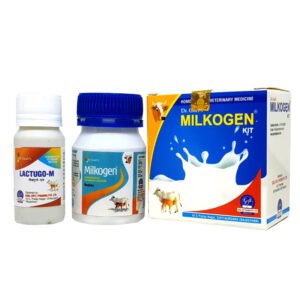 MILKOGEN KIT for Increasing Milk in Punganur Cow
MILKOGEN KIT for Increasing Milk in Punganur Cow
MILKOGEN Kit is an excellent Homeopathic Veterinary Medicine used in Cows and Buffaloes to increase milk yield naturally. It is a natural replacer of oxytocin hormone without any contraindications or side effects but with a definite increase in the milk yield. It increases the milk quantity and fat percentage of the milk to the full potential of an animal.
TEATASULE FIBRO GOLD KIT For Mastities Issue In Punganur Cow
TEATASULE FIBRO GOLD KIT is the best Homeopathic Veterinary Medicine for female animals in the case of chronic and clinical mastitis. TEATASULE FIBRO GOLD KIT is very effective in case of chronic or clinical mastitis when the udder is as hard as a stone, teats are shrunk with fibroids developed in the teats, and in teat cracks.
Marigold+ LSD-25 Kit For Lumpy Skin Diseases
Marigold+ LSD-25 Kit is For boosting immunity against LSD and other similar viral diseases. It is a Homeopathic Treatment of Lumpy Skin Disease (LSD) in cattle with oral medicine for enhancing internal Immunity and Healing Spray for treating external wounds.
Pyrosule-XP for High Fever in Cattle
PYROSULE-XP for CATTLE is the best Homeopathic Veterinary Medicine for Cattle that protects animals from infection. PYROSULE-XP relieves muscular and nervous pain that occurs during a fever and even decreases the severity of the fever.
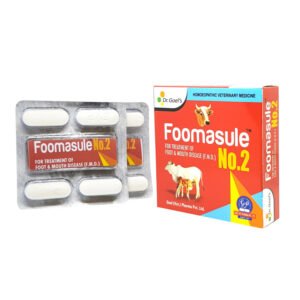 FOOMASULE NO. 2 for Foot and Mouth Disease
FOOMASULE NO. 2 for Foot and Mouth Disease

ProlapsGo For Prolaps Problem In Cattle
PROLAPSGO for cattle is the best Homeopathic Veterinary Medicine for Pre-partum or Post-partum prolapse of the uterus in cows & buffaloes. PROLAPSGO gives fast and long-lasting relief in case of prolapse of the uterus in cows and buffaloes. It can be sprayed directly over the prolapse of the uterus and can also be administered orally.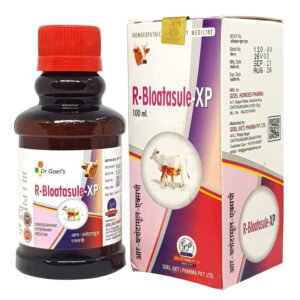
R.Bloatasule-XP For Bloating Issue in Cattle
R. BLOATASULE XP is the best Homeopathic Veterinary Medicine that is helpful for the treatment of indigestion, anorexia, and liver disorders.Check out: – GOHEAL SPRAY
Check out: – HEMISEPT for CATTLE – 100ML




